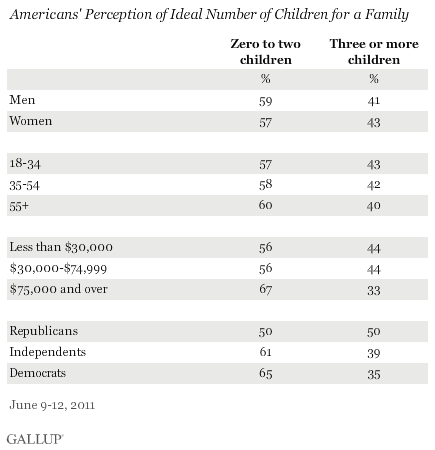PRINCETON, NJ -- Americans' long-standing preference for small families has edged slightly higher in recent years, with 58% of U.S. adults now saying that having no more than two children is the ideal for a family. One-third favor having three or more children, the lowest seen on this measure since 1996.

Gallup first measured Americans' preferred family size in 1936, at which time close to two-thirds (64%) thought three or more children was ideal. This view stretched to 77% at the end of World War II and remained near 70% for an additional two decades. But attitudes quickly shifted in the 1970s following publication of the book "The Population Bomb" in 1968 that warned of calamitous risks of overpopulation. Societal changes regarding the role of women may also have played a part in advancing Americans' preference for small families.
Since 1977, the majority of Americans have said having no more than two children is best. After reaching a high of 66% in 1986, this fell to 50% in 1997 and remained in the low 50s through 2004. More recently, the preference for smaller families is again on the rise -- from 53% in 2004 to 56% in 2007 and 58% in 2011 -- perhaps the result of persistent economic problems.
U.S. birth rates have been dropping in recent years. The Centers for Disease Control and Prevention (CDC) in March reported that the country experienced a four percentage point decline in live births between 2007 and 2009 -- a finding, as the CDC notes, that some researchers have attributed to the 2008-2009 recession.
Upper-Income Americans Think Fewer Children Is Ideal
In what could be an important contributor to marital tranquility, men and women have nearly identical conceptions of what the ideal number of children is for a family. The new poll also finds no major generational gaps in this outlook.
There are, however, significant income differences, as Americans in households earning $75,000 or more per year are more likely to favor small families than adults in lower-income households.
There is also a significant partisan difference, with nearly two-thirds of Democrats favoring smaller families, compared with 50% of Republicans who say the same. Whether this actually translates into higher population growth among Republicans is an important question that requires further study.

Bottom Line
After a brief reversal a decade or so ago in the contemporary trend toward preferring smaller families, Americans are again growing less likely to favor having three or more children and, correspondingly, more likely to say having two or fewer is ideal. This could be an important indicator for the future as prior Gallup research has indicated the trend lines for preferred number of children and the U.S. fertility rate have been parallel over the past 40 years. Currently, the average preferred number of children is 2.5, while the fertility rate is about 2.1 -- fairly close to the population replacement rate for Western countries. This suggests that if cultural preferences continue to shift toward smaller family sizes, the fertility rate could drop below the threshold needed to maintain the population, as it has in much of Europe.
Survey Methods
Results for this Gallup poll are based on telephone interviews conducted June 9-12, 2011, with a random sample of 1,020 adults, aged 18 and older, living in all 50 U.S. states and the District of Columbia.
For results based on the total sample of national adults, one can say with 95% confidence that the maximum margin of sampling error is ±4 percentage points.
Interviews are conducted with respondents on landline telephones and cellular phones, with interviews conducted in Spanish for respondents who are primarily Spanish-speaking. Each sample includes a minimum quota of 400 cell phone respondents and 600 landline respondents per 1,000 national adults, with additional minimum quotas among landline respondents for gender within region. Landline telephone numbers are chosen at random among listed telephone numbers. Cell phone numbers are selected using random-digit-dial methods. Landline respondents are chosen at random within each household on the basis of which member had the most recent birthday.
Samples are weighted by gender, age, race, Hispanic ethnicity, education, region, adults in the household, and phone status (cell phone only/landline only/both, cell phone mostly, and having an unlisted landline number). Demographic weighting targets are based on the March 2010 Current Population Survey figures for the aged 18 and older non-institutionalized population living in U.S. telephone households. All reported margins of sampling error include the computed design effects for weighting and sample design.
In addition to sampling error, question wording and practical difficulties in conducting surveys can introduce error or bias into the findings of public opinion polls.
View methodology, full question results, and trend data.
For more details on Gallup's polling methodology, visit www.gallup.com.
